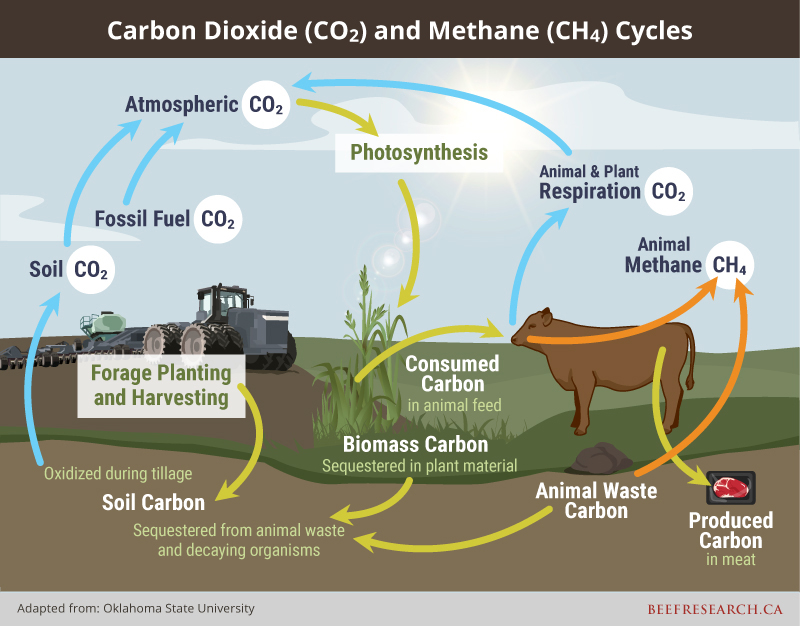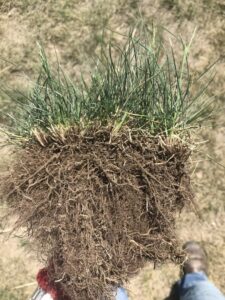Beef Cattle & the Carbon Cycle – a New Webpage
Remarque : cette page web n’est actuellement disponible qu’en anglais.
Carbon is a hot topic these days with individuals, organizations, and entire industries working to better understand the environmental implications of their activities. Terms like “carbon sequestration,” “climate change,” “carbon footprint,” and “greenhouse gas emissions” are often used in the news and on social media. What do these terms mean? What role does beef production play in the carbon cycle? How can carbon sequestration and greenhouse gas emissions impact beef producers on their farms?
The Carbon Cycle
Every living thing contains carbon and everything – including cattle and grasslands – are part of a carbon cycle. Carbon cycles are dynamic and vary around the world, by region, and even by farm, depending on different management practices.
Measuring emissions and sequestration in beef production depends on the type of life cycle analysis performed (i.e., birth-to-consumption vs. birth-to-slaughter). When people attempt to compare carbon footprints that analyse different portions of the beef production life cycle – or entirely different industries – these comparisons can be inaccurate and even misleading.
Raising cattle can have both positive and negative impacts on the carbon cycle and different management practices can increase or decrease the sector’s carbon footprint.

On one side of the equation, cattle emit greenhouse gases like enteric methane (CH4), a natural by-product of rumen fermentation. A management practice, such as including a feed additive like monensin, can help reduce enteric methane emissions while still enabling cattle to convert roughage into nutrient-rich beef. Burning fossil fuels for feeding or forage operations is another example of emissions, this time carbon dioxide (CO2). Producers can reduce carbon dioxide emissions by implementing extended grazing to reduce reliance on daily feeding.
On the other side of the equation, perennial forages and grasslands – the foundation of the beef cow-calf sector – are a critically important part of the carbon cycle because of their sequestration potential in Canada and worldwide. Forages and grasslands capture carbon dioxide (CO2) during plant growth, and sequester carbon in underground roots. Grasslands store up to 30% of the world’s organic carbon, and perennial grasslands are particularly effective carbon sinks, storing up to 97% of their carbon belowground.
Carbon Sequestration on Grasslands
Carbon sequestration is a dynamic process. Plants take in carbon dioxide (CO2) from the atmosphere during photosynthesis for plant growth, release oxygen into the atmosphere, and sequester carbon underground within their root systems.
All plants, including trees, annuals, and native and tame perennial grasslands, sequester carbon, however not all carbon sinks are equal. In stable conditions, forests sequester more carbon in timber, leaves and needles, than grasslands can store above and below ground. However, when a forest fire occurs, much of this carbon is promptly released back to the atmosphere during combustion. Fire suppression, drought, and insect infestations put carbon sequestered in forests at risk of release. In contrast, by storing the majority of their carbon belowground where it is protected from fire, grasslands provide a more stable carbon sink.
Annual crops sequester the least amount of carbon underground. Annual cropping systems are important for food and feed production, however compared to native grasslands, annual cropland often provides fewer ecosystem benefits, such as reduced biodiversity, reduced carbon storage, decreased soil water availability, and decreased soil porosity.

Scientists estimate that between 50 and 200 tonnes of carbon per hectare is stored in Canada’s grasslands, with an additional 3 to 12 tonnes of carbon per hectare stored in above-ground plant growth and plant litter. Most of the carbon sequestered is typically contained in the top 15cm of the soil. Soil organic carbon can also increase with grazing, particularly in the surface (0-15cm) soil, with minimal changes below this depth. Increased soil carbon may be caused by the ongoing animal impact that is responsible for trampling litter into soil, a grazing-induced plant response which causes plants to set down additional shallow roots following grazing, as well as an increase in the growth of individual plant species with higher grazing tolerance.
Carbon Storage and Land Use Practices

Historical land use change is the single largest disturbance of grassland carbon, leading to an estimated global loss of 30-50% of grassland carbon stores. Practices such as converting grassland to cropland, draining wetlands, and construction such as urban development and transport infrastructure, lead to carbon loss.
Changes in carbon stocks occur in the short term and over a long period of time as well. For example, when a grassland is cultivated for annual cropping, there will be a rapid loss in carbon stocks during the first few years of cultivation, however carbon may continue to be lost from the system for several years after, eventually reaching an equilibrium at a much lower level. Beneficial land use practices, such as revegetating annual cropland to perennial forage or using livestock manure as a fertilizer can help rebuild carbon stocks, but it remains unclear as to whether the previous carbon stocks can be restored, and if so, how long it may take.
It’s estimated that Canada once had 61,500,000 hectares of natural grassland, of which approximately 1,540,000 hectares remain, primarily in smaller fragments. The conversion of natural grassland to annual cropland represents a loss of carbon stocks estimated between 20% and 60%. While grasslands sequester carbon and cycle other nutrients, these valuable landscapes also provide numerous ecological services including biodiversity conservation; habitat for wildlife, species at risk, and pollinators; flood mitigation; sediment trapping and buffering; water filtration and retention; and soil conservation. The conversion of grasslands to other land uses impacts carbon sequestration negatively, but also causes a loss of other ecological benefits.
Left intact, Canadian grasslands can and have been building carbon stores. In a study that looked at carbon sequestration over an 80-year time frame, there was a general gain in net carbon on grazed pastures in the Great Plains, particularly in recent decades, and soil organic carbon increased during that time frame at a rate of 190 kg of carbon per hectare per year.
Management Practices to Increase Carbon Sequestration
Farms that implement management practises that promote removing carbon dioxide from the atmosphere (through plant growth) and sequestering that carbon belowground (in the root system and soil) may be more resilient and adaptable to changing climatic conditions. There are some on-farm practices that producers can implement to increase sequestration and stability:
- Avoid converting perennial grassland to annual cropland. After annual cropland is planted to perennial forage, revegetated land is slow to recovery and may not fully recover root mass and soil organic matter, even after 50 years.
- Converting annual cropland to perennial forage is a carbon storage opportunity, however data is unclear on how much carbon is sequestered over time. However, in addition to carbon storage opportunities, converting annual cropland, particularly marginal land, to perennial forage does provide additional ecological benefits, including improved habitat and biodiversity, reduced soil erosion, and increased water retention.
- Canadian studies have shown that moderate grazing can increase soil carbon concentration, particularly in the top 15cm of the soil surface. Grazing appears to be more beneficial for soil carbon in moister grasslands than in dry areas. Moderate grazing can also enhance other ecological services, including plant diversity and forage production.
- Native grassland plant species tend to have higher root-to-shoot ratios than tame forages and tend to have more root mass belowground than tame species. When revegetating annual cropland to perennial grassland, including native plant species may be an effective way to increase carbon storage.
- Left undisturbed, wetlands typically store more carbon than they release, resulting in net carbon sequestration. Wetland restoration can help re-establish ecological functions on these sites, and Canadian studies have indicated that carbon sequestered on newly restored wetlands as well as older restored wetlands result in a net carbon benefit.
Moving Forward
There is a growing interest in trading carbon through credits or offsets. Pilot projects across Canada are being set up, including the Canada Grassland Project Protocol. Led by the Canadian Forage and Grasslands Association, this project, which has numerous provincial and national partners, will help producers determine how much carbon they sequester in pastures and wetlands under different management practices and production systems. When carbon stores are better quantified on a farm-level, farmers may be able to establish a value for the carbon they are sequestering and trade carbon offsets in the future.
Beef production in Canada has a distinct carbon cycle that includes inputs and outputs, and greenhouse gas emissions and carbon storage. While there are challenges that the sector must overcome, including reducing emissions and meeting ambitious industry-leading targets, there are also great opportunities. Canadian researchers are working toward understanding practices that support carbon sequestration and methane reduction in beef cattle production. At the same time, technology and innovation are allowing producers to become more efficient at producing beef, and there is an opportunity to understand the incredible value that grasslands and forages present for carbon sequestration.
To learn more about beef cattle and carbon cycles, visit our new webpage.
Click here to subscribe to the BCRC Blog and receive email notifications when new content is posted.
The sharing or reprinting of BCRC Blog articles is welcome and encouraged. Please provide acknowledgement to the Beef Cattle Research Council, list the website address, www.BeefResearch.ca, and let us know you chose to share the article by emailing us at info@beefresearch.ca.
We welcome your questions, comments and suggestions. Contact us directly or generate public discussion by posting your thoughts below.